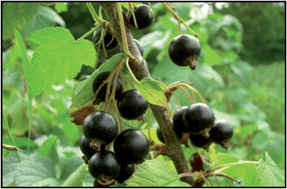The blackcurrant (Ribes nigrum L., Grossulariceae), a small, perennial shrub native to central Europe and northern Asia, is cultivated throughout the world, including the United States. In addition to its anecdotal use in traditional herbal medicine, modern laboratories have demonstrated the potent anti-inflammatory, antioxidant and antimicrobial effects of blackcurrant constituents on a myriad of disease states. The properties of the blackcurrants are conferred from its biochemical constituents, some of which include anthocyans (specifically delphinidin-3-O-glucoside, delphinidin-3-O-rutinoside, cyanidin-3-O-glucoside and cyanidin-3-O-rutinoside), flavonols, phenolic acids and polyunsaturated fatty acids. A plethora of studies have been published with regards to its various therapeutic applications. This article attempts to summarize these studies, providing a general overview of the research in this field. Several studies focus on the therapeutic potential of blackcurrants with regards to hypertension and other cardiovascular-associated illnesses, neoplastic, neurodegenerative and ocular diseases, nephrolithiasis, and diabetic neuropathy. Safety concerns and future directions are also mentioned, suggesting the critical examination of the exact mechanism of action, specific radical-scavenging capabilities of the blackcurrants and the crucial need for well-designed clinical trials to ensure the successful use of blackcurrants in a clinical setting.


 Please wait while we load your content...
Please wait while we load your content...